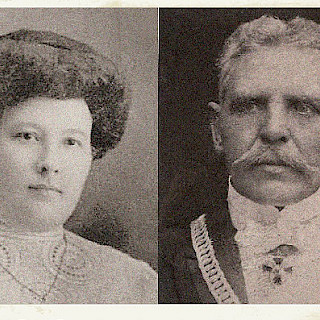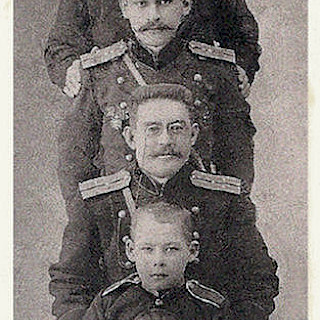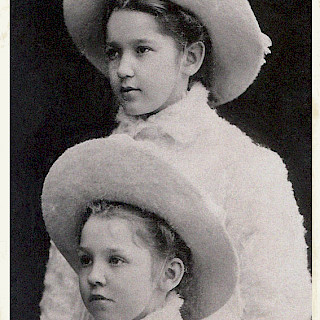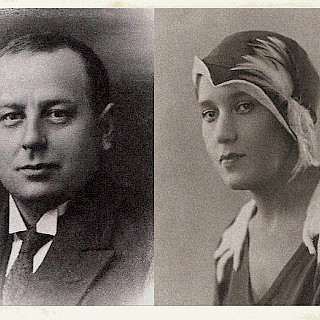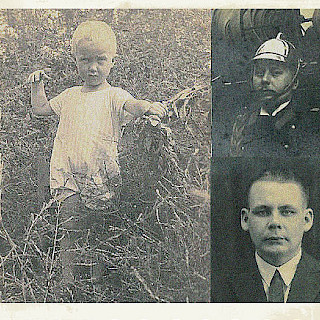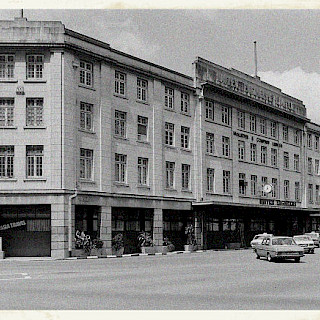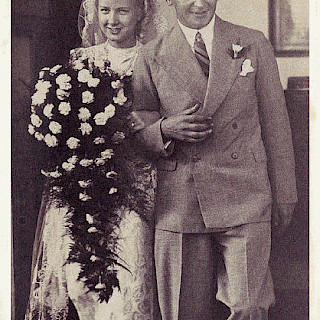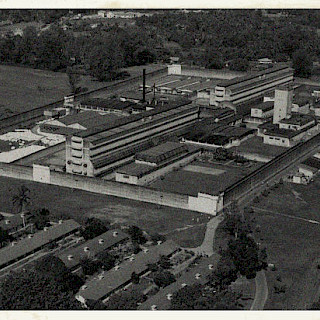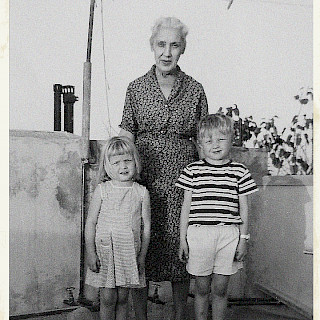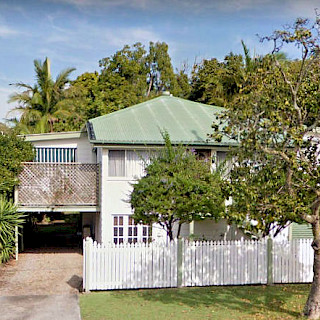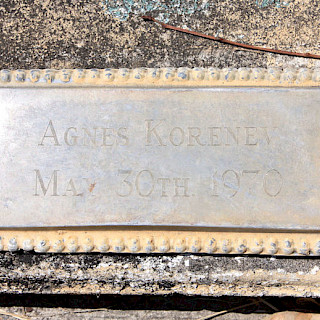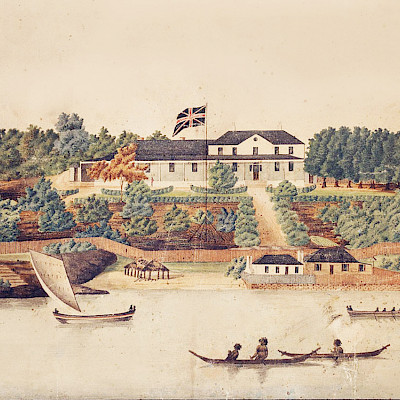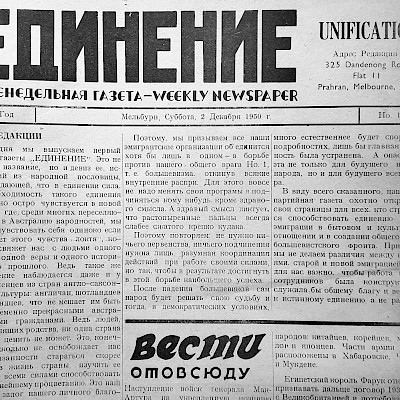After reading my article about Captain 2nd rank Korenev in Unification, Keith Clark, the grandson of Agnia Prokopyevna Vachtel who was the second wife of Mikhail Mikhailovich, contacted me. In the process of our subsequent discussion it became clear that Agnia’s story was no less interesting and dramatic than Mikhail’s, so we decided to write about it in more detail for our readers.
However, first things first. Agnia's father, Procopius (Prokopy) Petrovich Khabaroff, was a titular councillor, county treasurer and member of the Amur Presence for Peasant Affairs. In 1883, he married the American Agnia Barr, and the family had three sons: Ivan (b. 1884), Innokenty (b. 1886), George (b. 1890), and a daughter, Ludmilla (Lydia). Nothing more is currently known about the fate of their mother.
A few years later, Prokopy Petrovich married for a second time. His new chosen one was Raissa Ivanovna Stepanova, who was 24 years younger than her husband. She gave birth to three more children with her husband: Mikhail (b. 1896), Agnia and Militsa (b. 1902). Agnia was born on January 12, 1898 in Nagasaki, Japan. Presumably, her father was there as part of a diplomatic mission - in March of that year, an agreement was signed on the transfer to Russia of the lease for the Liaodong Peninsula with the cities of Dalian (Dairen) and Port Arthur.
All of the sons in the family became military men - in 1888, a preparatory school for the Siberian Cadet Corps was opened in Khabarovsk which later transformed into the Khabarovsk Cadet Corps. From 1908 it bore the name of the Governor-General of Eastern Siberia, the founder of Blagoveshchensk, Vladivostok and Khabarovsk - Count Nikolai Nikolayevich Muravyov-Amursky. It is also known that in 1904 Innokenty graduated from the Konstantinovsky Artillery School in St. Petersburg, and in 1914 Mikhail graduated from the Moscow Alexander Infantry School in the 1st category.
Ivan, with the rank of second lieutenant, commanding a platoon of the 6th East Siberian Rifle Artillery Brigade, was seriously wounded on April 18, 1904 near Tyurenchen, the first major battle of the Russo-Japanese War. In the same place, Innokenty fought and was also wounded. Staff Captain Ivan Khabarov died in 1915, during World War I, and the name of Mikhail, second lieutenant of the 208th Infantry Regiment of Lori, is on the lists of the Knights of St. George - in 1917 he was awarded the Golden Sword. However, the family believes that he was killed in action in 1915.
Information about the fate of Innokenty is more contradictory. According to some sources, in November 1914, during the Lodz operation, in the very first battle near Breziny (Brzeziny), he was wounded, captured and died there in 1917. On the site dedicated to the officers of the Russian Imperial Army, there is information that Innokenty Prokopyevich Khabaroff (though born in 1878) was arrested in 1937, convicted by the NKVD Troika under the "famous" Article 58 for counter-revolutionary activity and on April 29, 1938 he was executed by shooting.
The youngest daughter of Prokopy Petrovich, Militsa, died in childhood from diphtheria. The retired State Councillor Khabaroff is mentioned in the metric book of the Assumption Cathedral of Khabarovsk in the wedding record of July 26, 1917 as a witness on the side of the bride. No more information was found about him or his wife. Of all his children who survived the whirlwind of tragic events of the early 20th century, only George, Ludmilla and Agnia remained.
In 1920, Agnia married an Estonian Arthur Karl Friederick Vachtel and took Estonian citizenship and a year later their daughter, Kyra, was born in Vladivostok. In 1922, after the defeat of the White movement in the Far East, among hundreds of thousands of other refugees, the family left Russia and ended up in Northern China. Four years later, Agnia was left alone with a small child in her arms - her husband had died of a heart attack. At first she lived in Tianjin, and then she moved to Shanghai where her brother and sister were located and she spent almost three years there; in 1930 she moved again - to Qingdao, but in the end she decided to return to Shanghai, where she got a job as a cashier and beautician in one of the many beauty salons.
In the 1930s, the city became one of the two largest centres of Russian emigration. According to various estimates, about 25,000 of our compatriots lived on the territory of the International Settlement and in the French concession. Russian enterprises and workshops, shops and restaurants worked in the colony, newspapers and books were published, various educational institutions were opened and a theatre was also built. However, peaceful life collapsed in the summer of 1937 - the war between Japan and China, which had been going on for several years, entered an active phase, and in August the battle for Shanghai began.
Despite the fact that the territories where foreigners lived were in relative safety, under the protection of troops of their countries, it was impossible not to be involved with what was happening around them. On August 14, as a result of a Chinese air raid on a Japanese cruiser in the harbour, several bombs fell on the International Settlement - thousands of people were injured and killed and torn bodies were then recovered from under the rubble for several of the following weeks. After that, women and children began to be evacuated from Shanghai, and Agnia and her daughter moved to Hong Kong for a while. Fierce fighting continued until November when the Japanese finally took control of the city.
It is not known exactly where and how George died, but the family believes that this happened during those tragic events. In 1938, Mrs Vachtel left for Malaya with her daughter and a year later, in Singapore, Kyra married a Scottish civil engineer, Thomas Clark, who worked for a local construction company, United Engineers Ltd. In May 1941, the couple had a daughter, Christine, and in mid-February 42, the Japanese captured Singapore. The Clark family, along with 3,000 other civilians, were thrown into the infamous Changi Prison. Nearby, in the old British barracks, there was a concentration camp where about 50,000 captured British and Australian troops were kept.
Kyra was expecting a second child, but Alexander, who was born in April of that year, died a couple of months later from bronchitis caused by exhaustion - it was difficult to feed a baby in these terrible conditions. The prisoners were eventually released over three years later in September 1945, when British troops entered Singapore. Thomas returned to work and soon after his second son, Michael, was born. The head of the family was to take part in the construction of many and varied facilities in England, Pakistan and also on the African continent. There, Peter and Keith were born, and another daughter, Raiya, named after Kyra's grandmother.
For some unknown reason, in 1940, Kyra’s mother, Agnia, returned to Shanghai, but with the outbreak of World War II, the situation had changed considerably - the Japanese had taken full control of the entire city, and no longer stood on ceremony with foreigners. On the slightest suspicion, people were thrown into the infamous Bridge House - a large residential building converted into a prison, and later many residents were herded into concentration camps, of which there were 19 in the district. It is not clear what Agnia Prokopyevna was accused of, but she was also arrested and ended up behind bars. By some miracle, she still managed to escape and moved to Dairen - according to the Australian immigration questionnaire, she lived there from 1942 and was a dressmaker.
It is also not known exactly when she met Mikhail Mikhailovich, who by that time had already retired from service in the merchant marine and worked as an assistant to the head of the production department in the local port. In April 1950 they got married. 5 years later, the Captain retired, but after the communists came to power, the situation in China began to heat up, and the couple decided to emigrate to Australia, where Agnia's sister Ludmilla now lived.
As her nephew Vitaly wrote in an appeal to the Department of Immigration: “We want these, no longer young people to come to a free country, where they could live in peace and quiet for the rest of their years.” Fate did not deal Mikhail Mikhailovich such a good hand, as after 4 years he died of a heart attack in the Brisbane General Hospital. In order not to be a burden on relatives, Agnia got a job as a maid in a hotel. Longing for her daughter, whom she had not seen for almost 20 years, she desperately tried to speed up the naturalization process so she could travel to see her, but failed to overcome bureaucratic barriers - a certificate of citizenship was eventually issued in 1963.
Keith said that he first met his grandmother in 1964, when she arrived in Karachi (Pakistan), where at that moment Kyra lived with her husband and children. Perhaps Agnia Prokopyevna would have been happy to stay with them, but because of his work, the engineer’s family often moved, and it was already difficult for Agnia to lead such a nomadic lifestyle – it was only in the late 1960s and after the head of the family had retired, that the Clark family finally settled in Scotland. Thomas died in 1979, his wife outlived him by 31 years.
The fate of the grandchildren of Agnia Prokopievna developed quite differently. Christine had heart problems from birth. After the war, her granddaughter was sent to live with relatives in England, where she grew up and became an accountant. In 1971, her weak heart again caused problems and there were also complications with her lungs. A few days before Christmas, despite the best efforts of expert doctors, Christine died in London's St. Marylebone Hospital. Michael also moved to the UK and worked in the same field as his sister until his retirement. Peter became a policeman and moved to America where he married. Raiya is still working in the oil industry and is currently based in Malaysia. Keith followed in his father's footsteps - having received a degree in physics, he became a laser engineer and then worked on many laser projects in countries around the world. He and his wife, Janet, are now English pensioners living in Yorkshire.
After returning to Australia, Agnia lived with her niece, Lydia Kriloff, in Radcliffe. She spent her final years at 27 Shield Street, the address listed under "place of death" in the burial record at Toowong Cemetery. On May 13, 1970, Agnia died of cancer and was buried in the grave beside her second husband. The date inscription on her memorial plaque is erroneous, or perhaps indicates the date of the funeral. The story about Agnia’s sister's family - Ludmilla (Lydia) Veriga, will be detailed in the second part of this article. A huge thanks to Keith Clark for his tireless research and preservation of his family heritage.
Victoria Smolin (Russia) and Keith Clark (United Kingdom)
Photos: 1, 2, 3, 5, 6, 8, 10 - from the K. Clark family archive, 7 - NLBS, 9-AWM, 11 - from open sources on the Internet, 12 - the author.
Photo captions:
01 – Agnia Prokopyevna Khabaroff
02 – Raissa Ivanovna and Prokopy Petrovich Khabaroff
03 – Father with sons: Ivan, Innokenty, George and Mikhail
04 – Younger sister - Militsa, died in childhood (1902-?)
05 – Agnia with her husband - Arthur Karl Friedrich Vachtel (1884 -1926)
06 – Kyra (1925), father and uncle - George (1890-1938?)
07 – United Engineers Ltd office was demolished in 1991
08 – Kyra and Thomas' wedding ceremony, 1940
09 – Changi prison and old British barracks (Singapore)
10 – Grandmother with grandchildren - Keith and Raiya (1964, Karachi, Pakistan)
11 – The house where Agnia spent the last years of her life
12 – Memorial plaque on a grave in Toowong Cemetery




